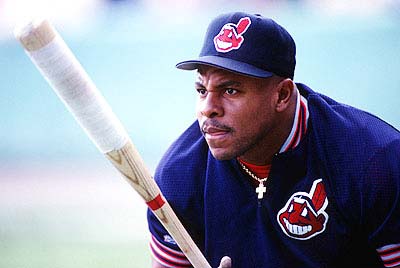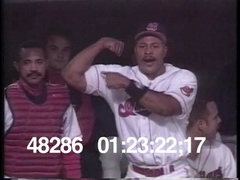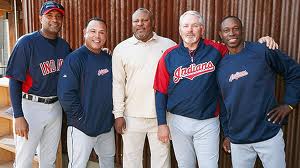This is one installment in a team effort by The Cleveland Fan, highlighting the top local sports figures by jersey number. Please weigh in with your thoughts on the "Boards". As David Letterman would say, "For entertainment purposes only; please, no wagering"
 In Cleveland sports history, there may not be a more feared player than Albert Belle. Opposing players feared him, his teammates feared him, the media feared him, and family and friends feared him. Belle was an intense competitor whose personality most resembled a burning stick of dynamite. It was all a matter of how long the wick was on that given day.
In Cleveland sports history, there may not be a more feared player than Albert Belle. Opposing players feared him, his teammates feared him, the media feared him, and family and friends feared him. Belle was an intense competitor whose personality most resembled a burning stick of dynamite. It was all a matter of how long the wick was on that given day.
Everybody has a different way of remembering Albert Belle. Some remember him for being one of the best hitters in Indians franchise history. Some remember him for being one of the most abrasive personalities ever to play in Cleveland. Some remember the corked bat. Some remember him for chasing down trick-or-treaters on Halloween in 1995. Some remember him for his chauvinistic tirade directed at Hannah Storm during the 1995 World Series. Some remember him for what he could have been, had a degenerative hip condition not taken its toll on his career. Some think he was a Hall of Famer. Some still call him “Joey”.
During the mid-90s, offense was all the rage in baseball. It was the heart of the steroid-era and tape measure home runs weren’t just a nightly occurrence, but an expectation every time a mistake was thrown to a hitter. Belle punished a lot of mistakes in his career, hitting 381 home runs in just 1,539 games. He hit in the heart of the order for the Indians from 1991-1996, hitting 234 home runs over that six-year span. Of Belle’s 381 career home runs, 40 tied the game, 125 put his team ahead, and six ended the game in walk-off fashion.
The Indians took a shot on Belle in the second round of the 1987 draft. A ticking time bomb from Shreveport, LA, Belle came with a lot of red flags. He had been disciplined at Louisiana State University for poor work ethic and insubordination. But, there was another thing that Belle came with. The ability to hit.
He rose quickly through the minor leagues, making his Major League debut before he even saw a pitch at the Triple-A level. He made his debut on July 15, 1989 and went 1-for-4 with a single. The hit was against Nolan Ryan. Five days later, Belle hit the first of his 242 career home runs with the Indians off of Randy St. Claire. Five days after that, he hit the first of 13 career grand slams off of future Indian Eric Plunk.
Before Belle would become a perennial All-Star, MVP candidate, and one of the game’s best sluggers, he would get in trouble several times. In June 1990, Belle took his frustrations out on a bathroom sink in Triple-A Colorado Springs and was forced to enter rehab for anger management and alcohol addiction. In May 1991, Belle launched a ball at a heckling fan and received a six-game suspension for his actions. The following month, Belle was sent back to the minors, despite leading the team in home runs and RBIs, for a lack of hustle. In May 1992, Belle charged the mound after a pitch flew behind his head and was suspended for three games. The following month, Manager Mike Hargrove benched Belle for two games for not hustling.
The times Belle thrived were the times when he directed his frustration at a baseball and not at other people. Once the frustration of adjusting to the Major Leagues subsided for Belle, he was in the news more for his hitting prowess than for disciplinary action. In 1993, the Indians’ patience with Belle paid off, when he hit 38 home runs, led the league in RBI with 129, and finished seventh in the Most Valuable Player voting. The 1993 season was the first in which the Indians lineup consisted of Belle, Jim Thome, Manny Ramirez, Kenny Lofton, Carlos Baerga, and Sandy Alomar. Contention seemed on the horizon with a lot of good, young, talented hitters and Belle was right in the thick of it.
The Indians and their fans had plenty of reasons to be optimistic in 1994. The team finally got out of the cavernous Cleveland Municipal Stadium and had a new home on the corner of Carnegie and Ontario. Jacobs Field, named for owner Dick Jacobs, was a beautiful new facility and it hosted an exciting product. Belle was the leader of the offense, bashing 36 home runs, driving in 101 runs, and batting .357 during the strike-shortened season. The strike likely cost the Indians their first division title in 40 years, as the season abruptly ended after game #113. The Indians were just one game behind in the standings.
The summer of 1995 was one of the most magical seasons in franchise history. The season started late, beginning on April 27 for the Indians, with 144 games on the strike-shortened schedule. As a team, the Indians hit 207 home runs that season, 50 of them by Belle. Belle completed a 50/50 season in doubles and home runs with 52 doubles and 50 home runs. To achieve the feat, Belle hit 31 home runs in August and September. He hit .381 over 30 games in August and .313 over 28 games in September and October.
 The Indians went 100-44 that season, winning the American League Central Division by 30 games. Unfortunately, the Indians ran into one of the best starting rotations ever assembled in the modern era, losing to the Atlanta Braves in four games. When it was all said and done, Belle had truly established his place in Indians lore. Belle was a serious contender for the MVP award, which would have made him the first Indians MVP since 1953, when Al Rosen won the award. At the time, Belle told USA Today, “It’s going to be tough. I’m not considered a media darling.” His rough relationship with the media did, in fact, cost him the MVP voting, as he finished second to Boston’s Mo Vaughn, a vote he lost by eight points.
The Indians went 100-44 that season, winning the American League Central Division by 30 games. Unfortunately, the Indians ran into one of the best starting rotations ever assembled in the modern era, losing to the Atlanta Braves in four games. When it was all said and done, Belle had truly established his place in Indians lore. Belle was a serious contender for the MVP award, which would have made him the first Indians MVP since 1953, when Al Rosen won the award. At the time, Belle told USA Today, “It’s going to be tough. I’m not considered a media darling.” His rough relationship with the media did, in fact, cost him the MVP voting, as he finished second to Boston’s Mo Vaughn, a vote he lost by eight points.
Belle had set a single-season franchise record in home runs, passing Al Rosen’s mark of 43 in 1953. He also set a single-season franchise record in extra base hits with 102, topping Hal Trosky’s mark of 96 in 1936. For other single-season records, Belle finished second in doubles, third in total bases, second in slugging percentage (a record he set in 1994), and first in at bats per home run (10.9).
Belle fell just short of 50 home runs in 1996, hitting 48, but drove in 148 runs, then the second-most all-time in a single season in franchise history. That would be Belle’s final season in Cleveland, as the team opted to let Belle go to free agency. He signed a five-year, $55M deal with the Chicago White Sox. Belle played two seasons with the White Sox, batting .301 and hitting 79 home runs. After that, Belle used an opt-out clause in his contract to hit free agency again. He wound up with the Baltimore Orioles, signing a five-year, $65M deal, the highest in Baltimore history up to that point. Belle played two seasons with the Orioles, hitting 60 more home runs before retiring to due a degenerative hip condition.
If you’re wondering up to this point where the details are on the 1994 corked bat scandal, the 1995 Halloween chase of kids through the neighborhood, and the 1995 World Series altercation with Hannah Storm are, I’m sorry, but you’re not going to find them here. My TCF colleague Greg Popelka wrote this tremendous piece about Belle back in June 2011. You can find details there.
The Belle that belongs on this list is the player. The hitter that electrified fans at Jacobs Field. The hitter that had a knack for coming through in the clutch, hitting 105 of his 381 career home runs in the seventh inning or later. The hitter that batted .297 with a .992 OPS with runners in scoring position over his career. The hitter who ranks second in slugging percentage (.580), fifth in on-base plus slugging percentage (.949), second in home runs (242), 10th in RBI (751), ninth in extra base hits (481), second in at bats per home run (14.2), and fourth in win probability added (20.1), all while having fewer plate appearances than most of the players ranked ahead of him.
 Without a doubt, Belle was a polarizing figure who wasn’t interested in the business of making friends. For years, he held a grudge against the Indians for letting him go after the 1996 season, choosing not to be a part of functions or acknowledge the team. But, Belle, who lives in Arizona, couldn’t resist the requests of his two former teammates, Kenny Lofton and Carlos Baerga, and made an appearance at Spring Training in Goodyear, AZ in 2012. The reunion gave us a picture that’s worth a thousand words.
Without a doubt, Belle was a polarizing figure who wasn’t interested in the business of making friends. For years, he held a grudge against the Indians for letting him go after the 1996 season, choosing not to be a part of functions or acknowledge the team. But, Belle, who lives in Arizona, couldn’t resist the requests of his two former teammates, Kenny Lofton and Carlos Baerga, and made an appearance at Spring Training in Goodyear, AZ in 2012. The reunion gave us a picture that’s worth a thousand words.
Belle will forever live on in Cleveland sports lore, with tales of his career passed on from generation to generation. The player and the person were two drastically different entities, one loved and revered, the other disliked and feared. If there’s one thing about Belle that cannot be debated, it’s the talent he had hitting a ball with a stick.
Belle’s #8 will never be retired in Cleveland, though his Hall of Fame credentials are certainly debatable. Because of his relationship with the media and his shortened career, Belle only received 7.7 percent of the Hall of Fame vote in 2006 and dropped off the ballot following in 2007 when he received 3.5 percent of the vote.
Even though Manny Ramirez and Jim Thome went on to have the best careers out of anybody from the mid-90s Indians, it’s hard to say that anybody had a bigger presence in the middle of those lineups than #8 Albert Belle.
Honorable Mentions:
Ray Fosse – It’s hard to say what might have become of Ray Fosse. Fosse, a first round pick in 1965, made the All-Star Game in 1970 on the strength of a tremendous first half, batting .312 with 16 home runs and an .893 OPS. In that game, Fosse was famously involved in a collision at home plate with Pete Rose, in which Fosse separated his shoulder. Fosse was never the same player again, only hitting 43 more home runs in his career following the injury. He finished his 12-year career as a .256 hitter.
Ken Keltner – Ken Keltner spent 12 seasons with the Indians form 1937-1949, batting .276 with 163 home runs. He was a seven-time All-Star and hit 31 home runs with 119 RBI in 1948 as part of the World Series champion Indians. He wore #8 from 1941-1944.